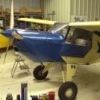
Weak point in the Kitfox tailwheel spring attachment design
Started by
wypaul,
21 posts in this topic
Create an account or sign in to comment
You need to be a member in order to leave a comment

Started by
wypaul,
You need to be a member in order to leave a comment